Introduction to the fediverse

What is the fediverse
The fediverse is a federated universe of different platforms (Mastodon, Peertube, Pixelfed, etc.) that connect with each other through the ActivityPub protocol, creating a social network of interconnected social networks. This allows users in the fediverse, regardless of which platform they use, to communicate between them wihtout having to create an account in each platform.
In the fediverse we could distinguish between two levels of federation:
- Federation within the same application
- Federation between applications
The first level is the federation within the same application, which allows Mastodon, for example, to be a decentralized social network because all Mastodon servers1 are federated to each other, so regardless of where the user has created their account, they can communicate with all Mastodon users across all Mastodon servers.
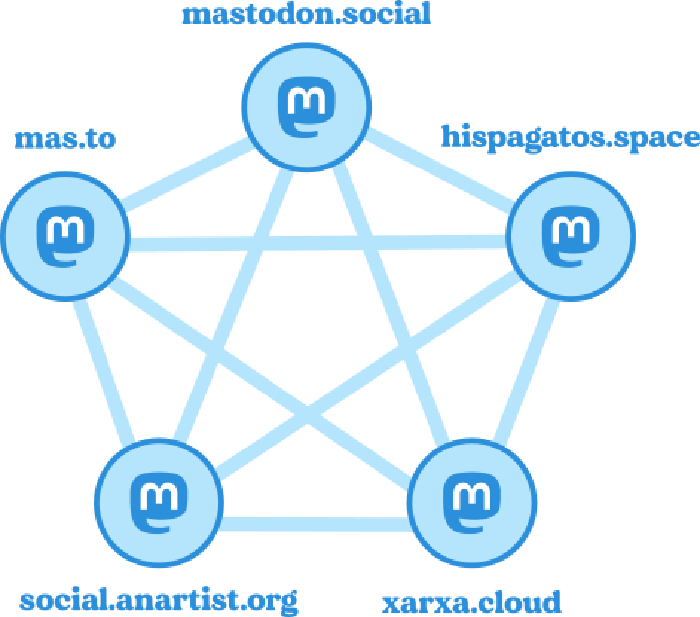
This is why account identifiers (“usernames”) in the fediverse are a little different from what we are used to, for example our Mastodon account is as follows: @criticalswitch@kolektiva.social. This can be broken down like this:

You can get the link to the instance where an account is registered from your full username, in our case the link to our instance is https://kolektiva.social.
The second level of federation is the federation between the various platforms (Mastodon, PeerTube, Pixelfed, etc.) which allows communication between them without having to have an account in each of them.
By performing an analogy with the commercial social networks, if these were federated it would mean that from a TikTok account you could follow and interact with Instagram and Youtube accounts without having another account on these platforms.
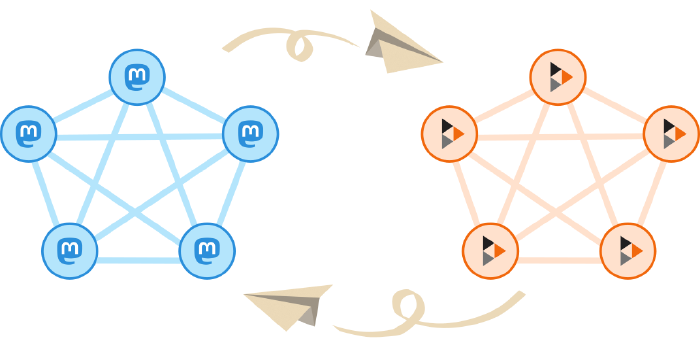
An more known example of a decentralized network is the e-mail: no matter who your mail provider is (
gmail,hotmail, tutanota, RiseUp, etc.), you can send and receive an email to any account that have a different email provider. If the email was centralized, those who had a RiseUp email accounts could only send and receive emails to people who have a RiseUp account, and the same for each mail provider.
The corporate social networks (instagram, tiktok, twitter, facebook, youtube, spotify, etc.) are centralized so only one entity has the control of the network, and they are hermetic because its business is based on attracting you into its platform to gather and sell your data, so they don’t want you to communicate with users of other social networks because then the wouldn’t be able to trap you as effectively. It’s a business model choice, not a technical limitation.
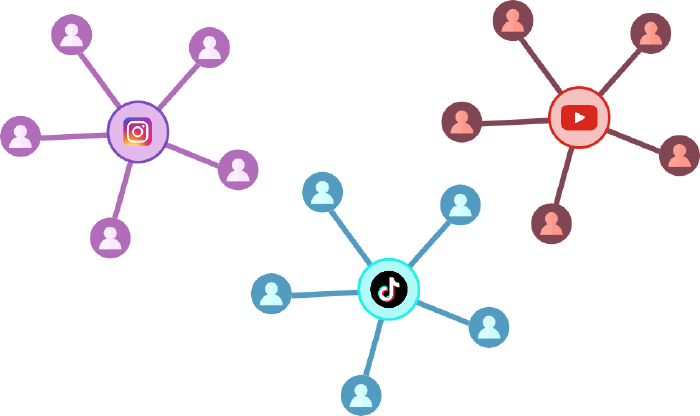
Why should I join the fediverse?
It is very difficult to build community within social networks controlled by technological companies, and when we do it’s despite of them. These companies are the ones who decide how, when and under what terms we interact on their platforms, which topics we are allowed to talk about and which not, always acting as an extension of the neoliberal interests. In the end, we waste more time fighting the platform itself than building community.
Use our time on their social networks (instagram, tiktok, twitter, facebook, youtube, spotify, etc.) means financing and legitimizing their existence, but above all it means unlearning ways to relate with each other that are more horizontal, autonomous and collective.
The goal of the corporate “social networks” is not to get people close but to catch them as long as possible in their products so they can collect users data, control their behaviours and sell them ads. It is not a social network, it is a social trap.
We need more autonomous digital spaces where we can experience Internet, where we can learn to relate to each other and organise without being mediated by corporations, while we also question the technologies that conform digitality and we reflect about our dependency on them.
The fediverse is a space where decentralization and self-management can be reality, it’s an opportunity to start to experiment with other possible worlds.

What about Bluesky or Threads?
First of all, a small description of these platforms to better understand their differences:
- Bluesky is a social network of microblogging that belongs to a Silicon Valley company funded with venture capital. It does not federate with the fedverse and it has its own protocol.
- Threads is a social network of microblogging owned by Meta, another company of Silicon Valley, which also owns Facebook, Instagram and Whatsapp. It can federate with the fediverse but the thing is, if we want them to join or if we resist their intrusion.
- The fediverse is a social network of social networks that are federated among themselves. The most well-known microblogging social networks that are part of the feverse are Mastodon or Misskey, both free, community and non-profit software.
It is important to stress that the fediverse is not just another alternative, like who buys cereals from one brand or another, is a more political action for the community, against centralization, fascism and capitalist companies control over our intimacy, our social interactions and the privatization of knowledge.
Bluesky
Interestingly, in this political crisis where the millionaires behind the big technological platforms (Meta, X, Apple, OpenIA, TikTok, Google, etc.) openly present themselves as collaborators of fascism, many media or individualities make propaganda of Bluesky as a better alternative to these commercial social networks while omitting any mention of Mastodon, Misskey or any other.
The reasons for presenting Bluesky as a good alternative to the most used commercial social networks have more of propaganda and advertising than of founded facts. Its great media presence is really due to its immense capital investment and being another Silicon Valley company that does not really question centralized technology and its toxic dynamics, capitalist progress or other neoliberal ideas that condition the conception of a technology.
Bluesky is literally the same type of commercial, centralized and neoliberal social network, it is controlled by the same kind of millionaires whom we expect one day to
guillotineor extinguish by redistribution of wealth.
On the other hand, the company of Bluesky states that its social network is decentralized. Decentralization would mean that any “normal” person, with sufficient technical knowledge, could have control and manage a part of the social network infrastructure, thus avoiding full control from a single entity. However, this statement is not true because it takes several millions of euros to maintain a bit of this infrastructure that would ensure decentralization, so it is unattainable for any worldly person.
Threads
Threads is a social network owned by one of the most powerful technological companies so it is quite clear that it is not a freer alternative if what we are looking for is to escape from corporate digital spaces controlled by neoliberals.
It is important to note that Threads, unlike Bluesky, can federate with the rest of the fediverse and, consequently, many people from the fediverse community have reacted strongly to this capitalist incursion in our little oasis by blocking have the federation with this social network. This means that, depending on which server you create your account in the fedverse, it is possible that it will not be federated with Threads by political decision and to protect the users of such server. As a result, no posts will be shown that come from that social network in your timeline, nor will you appear in theirs.
Platforms that are part of the fediverse
The platforms that are part of the fediverse are several, however, you have to bear in mind that although many of them are similar to the format of the commercial platforms, they are not the same. For example, Pixelfed would be Instagram’s alternative, but the approach and the functionalities are not necessarily the same.
There may be things you can currently do in Instagram but not in Pixelfed, however there are infinite more things that you can do in the latter that you can’t do in Instagram. This applies to any platform of the fediverse.
Some alternatives to commercial social networks are (there are many more):

There are other interesting platforms that are not social networks but are federated with the fediverse:
- Gancio: community manged agenda. The calendari.cc project in València and the convoca.la agendas use this platform.
- Mobilizon: to organize events and participation, alternative for Facebook events or the Meetup website.
- WriteFreely: simple blog to write long publications.
Where to create an account
The experience in the fediverse is more enjoyable if you choose a server1 on which to create an account that relates to your interests and principles. The following considerations could be considered when choosing a server:
- Think what you want to publish or how you will us the platform. For example, if you just want to interact and create a network, the most useful thing would be to create an account on a microblogging platform like Akkoma, Misskey or Mastodon, on the other hand, if you want to upload videos and images then a Pixelfed account.
- Read the instance’s code of conduct2 to ensure that it does not allow certain attitudes (e.g. section “server rules” of the instance fe.disroot.org) and to ensure that you also meet its code.
- A good content moderation so you feel comfortable (instances with too many users are more difficult to moderate).
- The instances are your local community3 within the fediverse, choosing the appropriate theme could connect you from the beginning with many interesting people.
- Each platform allows a limited number of maximum characters per post. For example, Mastodon usually only allows 500 characters so if you think it’s short, other microblogging platforms like Misskey, Pleroma or Akkoma offer many more characters (or some modified versions of Mastodon).
We have collected several microblogging instances2 where you could create an account in the fediverse:
Remember: regardless of where you create your account, you can interact with the other users of the fediverse.
- xarxa.cloud: instance of Mastodon.
- fe.disroot.org: instance of Pleroma administered by the collective disroot.
- social.anartist.org: community of Mastodon of artists and creators.
- elbarri.online: is a node for catalan collectives that pretends to be a communal infrastructure managed by the community.
- owo.cafe: is a community of Mastodon transinclusive, anti-fascist and anti-capitalist for chill people who like to talk about their hobbies, including video games, cinema, books, role, comics, anime and manga, technology, art, crafts, etc.
- mastorol.es: community of Mastodon for role fans.
- hispagatos.space: community of Mastodon for hackers, Cyberpunks and anarchists who follow the hacker culture.
- kolektiva.social: instance of Mastodon anarchist.
- meetiko.org: instance of Sharkey (Misskey).
- comelibros.club: instance of Bookwyrm.
If you want to have a video channel, then you can explore instances of PeerTube. There is an alternative for everything! Explore all platforms at fediverse.info.
How to access the fediverse
You can access from the browser by accessing the link of the instance where you have created your account (e.g. https://xarxa.cloud). In addition, there are several mobile applications, other than the official, that allow you to log in with one or more accounts, here you can explore the different apps.
We recommend that you try to use other applications than the official ones because they usually offer more funcionalities. We recommend the following:
- Moshidon for your
Mastodon account:
- Allows you to log in with more than one account
- Allows to schedule posts
- Shows the pronouns (if specified) next to the username
- Shows a button in the posts to translate them when they are in another language.
- Pixelix for your
Pixelfed account.
- It appears from which platform is an account in the upper right corner when we are visualizing your profile (e.g. if it is a Pixelfed, Mastodon, Akkoma, Loops, etc.)
Who you can follow
Other lists
- Lista by @chinicuil
- List from the campaign La Furgo
Glossary
What is a server?
The most common way to access the Internet is using the client-server architecture where our device is the client that makes requests to a remote server. An example of a request to the server could be something like “show me the posts of this user” so the server would respond with the requested information and our device would display the data on the screen.
A server is, by simplifying a little, a computer that is always available to serve - so it has to by always powered on - and that stores the website or application that will be serve to a client. Nowadays, most of the servers are actually huge data centers that have a very serious ecological impact.
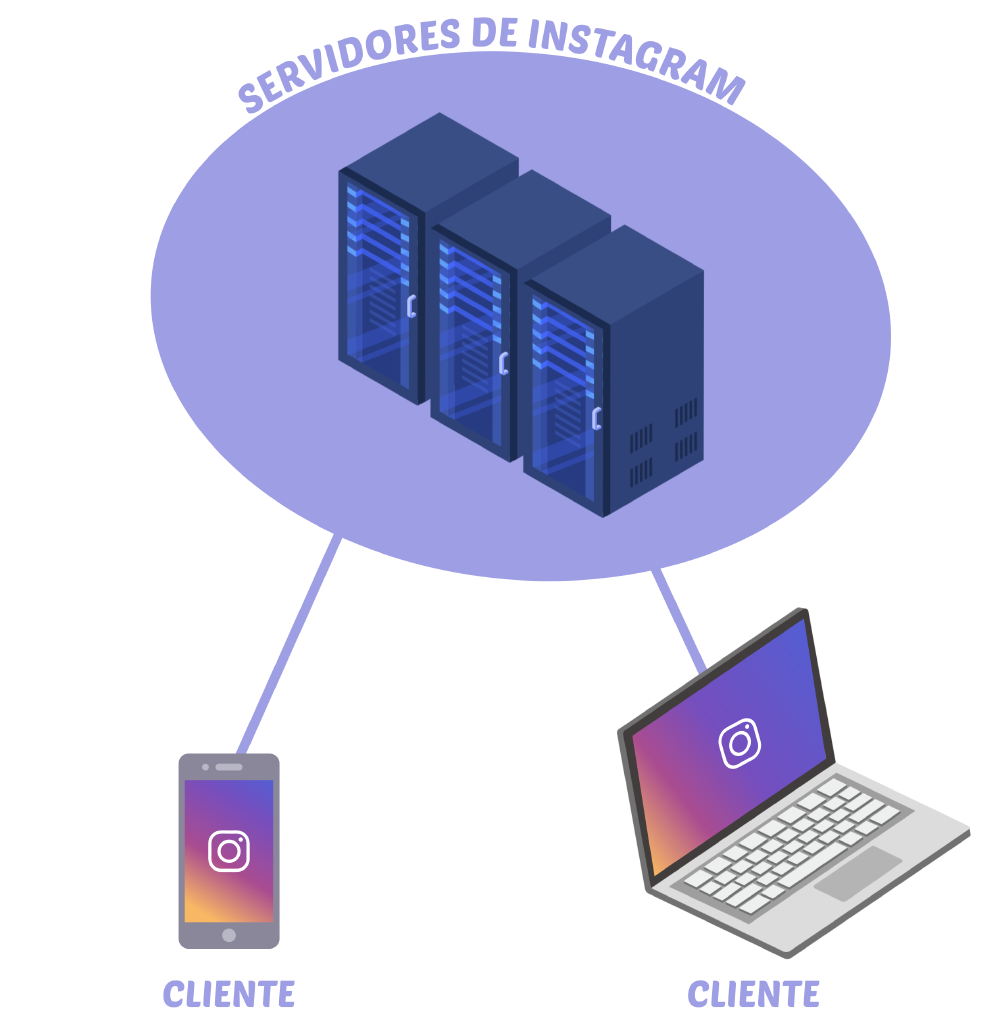
In the fediverse, our devices also connect to servers but the difference is that these servers are not under the control of a single entity or company, because thanks to the decentralized nature of the fediverse, anyone can potentially control their own server and be part of the federated universe.
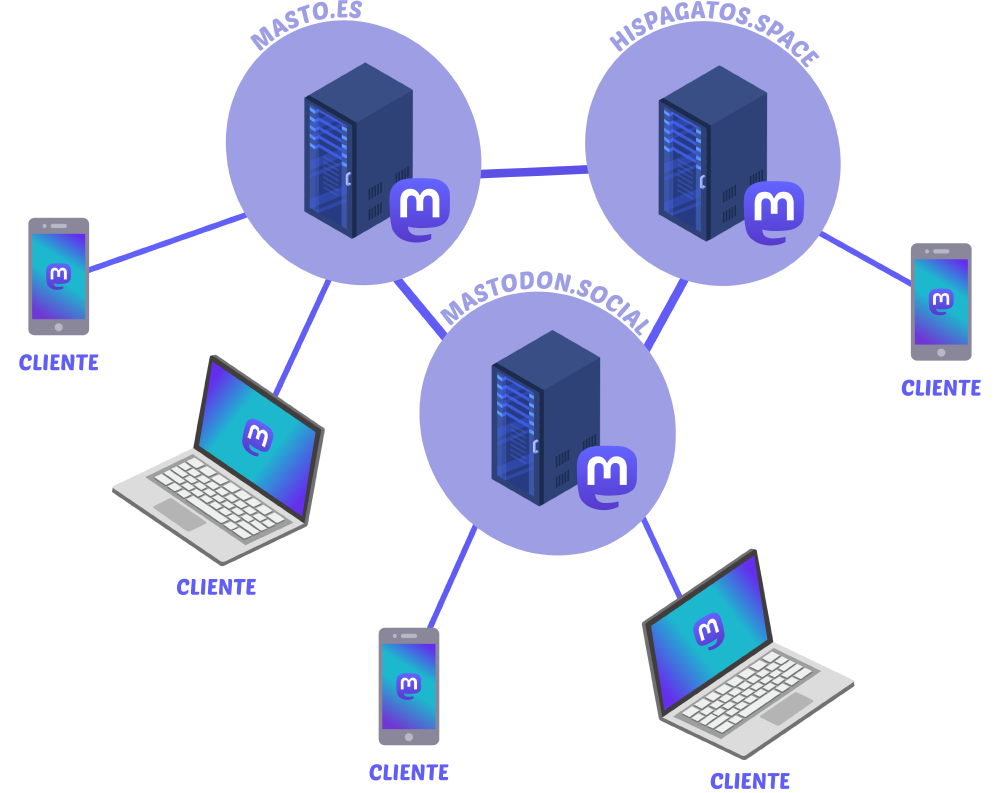
Instance
A instance or node is a server where the software of a fediverse application has been installed and configured (Mastodon, Pixelfed, PeerTube, etc.).
This server federates with the rest of the servers to form the fediverse, thus creating a decentralized network. Anyone with a minimum of technical knowledge can manage their own instance, so many instances of the fediverse are administered by individual volunteers or collectives. For example:
- the instance of Mastodon https://masto.es/about is administered by @rober@masto.es
- the instance of Mastodon https://mastorol.es/about is administered by @demiurgo@mastorol.es
- the instance of PeerTube https://veedeo.org/about/instance is administered by @kyva@meetiko.org
Local community
The instance where you have created the account becomes your “local community” since all users in that instance live under the same server, sharing the same home in the fediverse. This sense of community grows when the instance is thematic (political, LGTBIQ +, role, anime, anti-capitalist, etc.) or does not have millions of users. An analogy might be to think that the instance is your neighborhood (local community), which in turn connects with other neighborhoods by public transport.



